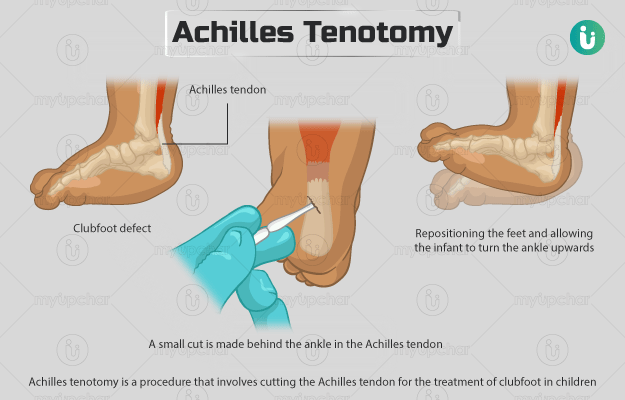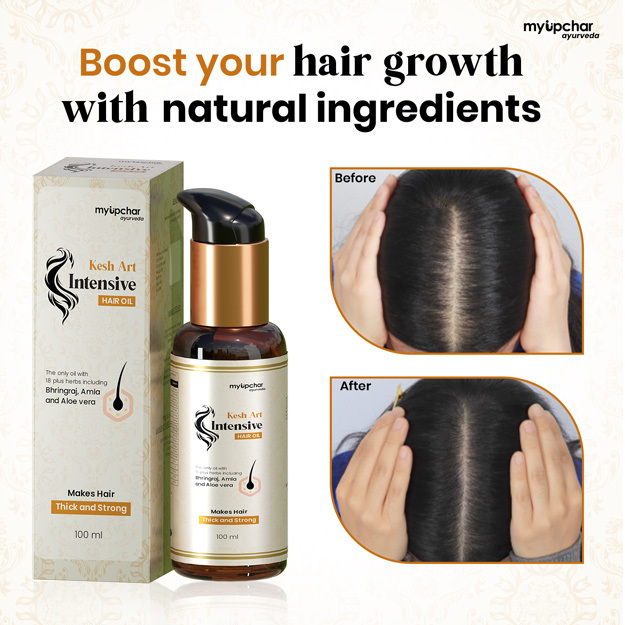Summary
Achilles tenotomy is a surgical procedure that involves cutting the Achilles tendon (tissue that connects the heel bone to calf muscles) for the treatment of clubfoot in children. Clubfoot is a birth defect, a foot deformity that can affect one or both feet. Although an infant with clubfoot feels no pain or discomfort during the early days, the condition can become painful and cause walking difficulty as the child gets older.
Achilles tenotomy is performed as a part of the Ponseti method that is considered to be the most used and accepted non-surgical treatment for clubfoot. Ponseti method involves manipulating the feet into a normal position and applying a cast over the feet every week. This procedure is repeated for nearly two months. However, many infants have a tight Achilles tendon that prevents the complete correction of the feet. In such infants, Achilles tenotomy is done, in which a small cut is made behind the ankle in the Achilles tendon. The incision does not require any stitches. A final cast is applied over the affected foot after the surgery. The whole procedure lasts for up to 45 minutes, including removal of the cast, cutting the Achilles tendon, and the application of the final cast. You will need to take the child to the hospital after three to four weeks to get the cast removed.
- What is Achilles tenotomy?
- Why is Achilles tenotomy recommended?
- Who can and cannot get Achilles tenotomy?
- What preparations are needed before Achilles tenotomy?
- How is Achilles tenotomy done?
- How to care for yourself after Achilles tenotomy?
- What are the possible complications/risks of Achilles tenotomy?
- When to follow up with your doctor?
What is Achilles tenotomy?
Achilles tenotomy is a minor surgical procedure performed as a part of the Ponseti method for the treatment of clubfoot.
Clubfoot is a congenital (present from birth) defect that causes the feet to point inwards and down with the sole facing backwards. The condition may affect one or both feet and is mostly painless in infants. However, with age, the child starts to experience walking difficulty and pain.
Clubfoot is normally diagnosed during a routine ultrasound scan performed in pregnant women. The treatment for the condition is usually started from the first or second week of the child’s life. Ponseti method is the primary treatment recommended for clubfoot. It is a non-surgical method that involves repositioning the foot close to the normal position and covering it with a cast. This technique is repeated every week for up to two months.
Many infants have a tight Achilles tendon that can affect ankle movement and activities even after undergoing treatment with the Ponseti method. Tendons are fibrous tissues that connect muscles to bone. The Achilles tendon connects your heel bone to your calf muscles and helps in the up and down movement of the ankle. Achilles tenotomy involves cutting the Achilles tendon to reposition the feet and allow the infant to turn the ankle upwards. The surgery is also called heel cord tenotomy/lengthening, percutaneous tenotomy, or tendo-Achilles lengthening tenotomy.
Why is Achilles tenotomy recommended?
Achilles tenotomy is usually recommended in children with clubfoot. The symptoms of clubfoot include:
- Short, broad feet
- Narrow heel
- The front part of the foot (one or both) faces downwards and inwards
- Sole of the foot faces backwards
- Small calf muscles (compared to a normal leg)
- Tightness in Achilles tendon
Who can and cannot get Achilles tenotomy?
Achilles tenotomy is carried out as a part of the Ponseti method. Some surgeons do not perform the Ponseti procedure in children who are:
- Older than two years of age
- Have diseases like myelomeningocele or arthrogryposis
What preparations are needed before Achilles tenotomy?
The surgery is performed before the application of the final cast in the Ponseti method. While going to the hospital, other than the child’s blanket, you should carry a pacifier (a rubber, silicone nipple the child can suck on), extra diapers, and a milk bottle. You will also be asked to carry socks and paracetamol for your baby.
How is Achilles tenotomy done?
After you and your child arrive at the hospital, the cast from the child’s leg will be removed, and the area will be cleaned. The medical staff will apply a cream (local anaesthesia) on your child's heel and cover the area with a dressing. The cream numbs the skin and minimises the pain of the injection given during the surgery. It requires about half an hour to take effect. Avoid breastfeeding the child while awaiting the numbing effect of the cream. This allows the surgeon or nurse to soothe the child by feeding them with the bottle in the operating room where parents may not be allowed. Once their heel is numb, the child will be moved to the operating room. The surgery usually involves the following:
- The surgeon will use a small surgical blade to make a tiny incision (cut) on the skin behind the ankle.
- After accessing the Achilles tendon through the incision, he/she will cut it carefully.
The cut will not be closed with stitches. This will take about one minute per leg. After cutting the tendon, the surgeon will put on another cast on the child’s leg. This will help hold their leg close to the maximum corrected position. The whole procedure, from the removal of the cast to the surgery and re-application of the new cast, takes about 45 minutes. The child will be discharged on the same day of surgery.
How to care for yourself after Achilles tenotomy?
The doctor will ask you to take the following care at home after an Achilles tenotomy:
- A small spot of cleansing solution or blood may be seen on the cast. Any drainage from the incision that creates a spot on an area of 1 ½-inch diameter is normal. Check the area several times a day. If you see more drainage, you should contact the doctor.
- The surgeon will prescribe medicines if the child is fussy due to pain and discomfort in the initial 24 hours following the procedure.
- Keep the child’s feet in an elevated position, either on a towel or pillow, for one to two days after the operation. This will help minimise the swelling around the operated area.
- Check the blood circulation in the child’s leg multiple times throughout the day in the initial two to three days after the surgery. Their toes should turn white on touch and then pinkish in 3 to 6 seconds. If the child's toes look discoloured, change the position of their leg to improve blood circulation.
- To prevent relapse of the condition, the child will be given boots-on-bar, which are to be worn full-time for 3 months and then nightly until they are 5 years of age. These are open-toed sandals with a bar that keep the feet in the out-turned position.
When to see the doctor?
Contact the surgeon if you observe any of the following symptoms in the child:
- Fever with body temperature over 101°F (38.5°C)
- Cracks in the cast
- The child acts irritable for unknown reasons
- Rashes or skin irritation
- Damp or wet cast
- Foul-smelling odour around the child’s toes or cast
- Presence of a foreign object inside the cast
- Increased swelling in toes
- Drainage spots of diameter greater than 1½ inches on the cast
- Change in temperature or colour of toes
- Toes slip inside the cast
- The cast appears looser or tighter than normal
When to follow up with your doctor?
The follow-up appointments required for every child varies. However, you may need to take the child to the hospital two to three weeks after the surgery to remove the cast. In addition, the child may need a visit at one and five weeks after surgery so the doctor can check the progress of their feet. Six weeks after the surgery, the treatment will resume with boots and bar. A physical therapist will check the child’s feet regularly.
Disclaimer: The above information is provided purely from an educational point of view and is in no way a substitute for medical advice by a qualified doctor.
Surgery Cost In Your City
References
- Nemours Children’s Health System [Internet]. Jacksonville (FL): The Nemours Foundation; c2017; The Ponseti Method: Casting Phase
- National Health Service [Internet]. UK; Club foot
- Oxford University Hospitals [internet]: NHS Foundation Trust. National Health Service. U.K.; Clubfoot
- Gillette children's specialty healthcare [Internet]. Minnesota. US; Clubfoot Treatment: Achilles Tenotomy
- Chelsea and Westminster Hospital [Internet]. NHS Foundation Trust. National Health Service. UK; Percutaneous achilles tenotomy in clubfoot (Ponseti method)
- Geiderman JM, Katz D. General principles of orthopedic injuries. In: Walls RM, Hockberger RS, Gausche-Hill M, eds. Rosen's Emergency Medicine: Concepts and Clinical Practice. 9th ed. Philadelphia, PA: Elsevier; 2018:chap 42
- Biundo JJ. Bursitis, tendinitis, and other periarticular disorders and sports medicine. In: Goldman L, Schafer AI, eds. Goldman-Cecil Medicine. 25th ed. Philadelphia, PA: Elsevier Saunders; 2016:chap 263
- Orthoinfo [internet]. American Academy of Orthopaedic Surgeons. Rosemont. IL. US; Achilles Tendinitis.
- Hospital for Special Surgery [Internet]. New York. US; The Ponseti Method for Clubfoot Correction: An Overview for Parents
- Hassenfield Children's Hospital: NYU Langone Health [Internet]. NYU Langone Medical Center. New York. US; Ponseti Method for Clubfoot in Children
- Cedars Senai [Internet]. California. US; Clubfoot in Children
- Palma M, Cook T, Segura J, Mayo L, Morcuende JA. Barriers to the Ponseti method in Peru: a two-year follow-up. Iowa Orthop J. 2013;33:172–177. PMID: 24027479.
- University Hospital Southampton [Internet]. NHS Foundation Trust. National Health Service. UK; What is Achilles tenotomy?
- Nationwide Children's [internet]. Nationwide Children's Hospital. Ohio. US; Clubfoot
- Gunter JB. Benefit and risks of local anesthetics in infants and children. Pediatr Drugs. 2002;4(10):649–672. PMID: 12269841.
- MacNeille R, Hennrikus W, Stapinski B, Leonard G. A mini-open technique for Achilles tenotomy in infants with clubfoot. J Child Orthop. 2016 Feb;10(1):19-23. PMID: 26825454.















